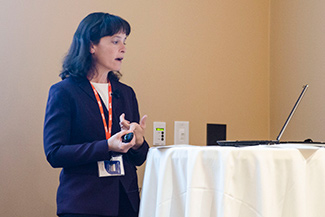Genetic Control of Feet and Leg Structure
K-State researchers evaluated if structural soundness was associated with stayability.
by Kaci Foraker, editorial intern
BROOKINGS, S.D. (June 19, 2019) — Many producers are seeing more problems with cattle’s feet and legs in the past five years, said Jennifer Bormann, Kansas State University animal breeding and genetics professor, at the 2019 Beef Improvement Federation symposium. She noted that years of intensely selecting for production or carcass traits might have led to neglecting structural integrity.

Jennifer Borman
There are many components of feet and leg structure that make them acceptable or unacceptable in the eyes of the producer. The main idea is to create an animal free from structural issues that could hinder their performance or reproduction, but tracking those traits can be difficult. [Photo by Kaci Foraker]
“If we can figure out a way to score soundness and feet-and-leg traits, then we can understand those relationships and figure out what might be related to longevity,” Bormann said. “Any time you put a number on something, you can put it into an evaluation to develop a genetic evaluation, which can help us make selections for some of these traits.”
What to select for
There are many components of feet and leg structure that make them acceptable or unacceptable in the eyes of the producer. The main idea is to create an animal free from structural issues that could hinder their performance or reproduction, but tracking those traits can be difficult.
“I think if you ask 10 different producers, you might get 10 different answers about what are the core components of structural soundness,” said Bormann.
She referenced work that has been done in the dairy cattle industry, which has a genetic evaluation for feet and leg structure. The main traits in that evaluation are side and rear view of the rear leg, foot angle and an overall structure score. All of these aspects have been combined into an index shown to have low to moderately low heritability.
From previous projects in Europe and Australia, Bormann’s team compiled 14 different traits to evaluate. These traits included front and rear hoof angle, front and rear heel depth, front and rear foot claw shape, size of hoof, front leg knee orientation, front leg hoof orientation, front and rear leg side view, rear leg rear view, and an overall composite score, as well as body condition score.
Working with registered Red Angus, Bormann gathered data from 1,800 animals that were predominately young cattle. Two evaluators looked at each trait on every animal and reported their findings on a slider scoring system that ranged from 1 to 100 with an exception of a 1-to-50 scale for the composite score.
“As you might expect, if you just look at the means of those traits, they are all centered right around 50, which is what we would expect with a standard deviation of five to six for most of those traits,” said Bormann. “More interestingly, when we start looking at the heritability, we were encouraged as they seem to line up with previous literature.”
Correlations
Though all of the correlations determined from the data were small, they could possibly be used as indicators or spark an additional research pathway. Bormann also found that some correlations between traits showed that certain traits could be evaluated together.
An upright hoof is more associated with being buck-kneed and a sloped hoof is more associated with being calf-kneed. Similarly, cattle with tall heels are associated with being buck-kneed and shallower heels are associated with being calf-kneed, she said. From the side view of the rear leg, the upright hoof and tall heel tended to be postlegged and the sloped hoof and shallow heel tended to be sickle-hocked.
“Our composite score was highly correlated with many subcomponents,” said Bormann. “This tells me that these are probably the things that the evaluator is picking out unconsciously when they give that overall score, which is highly influenced by the front leg and rear leg side view, as well as the hoof angle and depth. Those are the things that are driving those composite scores.”
However, Bormann said future work is needed to adjust the reporting scale, analyze different traits and accumulate more data.
“We didn’t find any silver bullets or one thing that we could use to solve longevity in a cow herd, but there did seem to be some traits we could measure that would have some low relationships in stayability and perhaps be used to predict stayability at younger ages,” said Bormann.
The 2019 BIF Annual Convention was hosted by South Dakota State University and the South Dakota Beef Breeds Council June 18-21 at the University Comfort Suites and Convention Center in Bookings. ANGUS MEDIA® provides comprehensive online coverage of the event at www.BIFconference.com. Visit the Newsroom for summaries, proceedings, PowerPoints, video and/or audio of the sessions and the Awards page for announcements and photos of award winners.
Editor’s Note: This summary was written under contract or by staff of ANGUS MEDIA®. Through an agreement with the Beef Improvement Federation,
we encourage reprinting of the articles to those who will adhere to the
reprint guidelines available on this site. Please review those
guidelines or contact Shauna Rose Hermel,
editor, at 816-383-5270. PowerPoints are posted with permission of the
presenter and may not be reproduced in whole or in part without the
express permission of the presenter. We welcome educational venues and
cattlemen to link to this site as a service to their audience.
For questions about this site, or to notify us of broken links, click here. Look for additional coverage in the Angus Journal, the Angus Beef Bulletin, the Angus Journal Daily, the Angus Beef Bulletin EXTRA and Angus TV.


